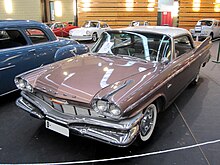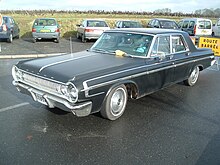Dodge Polara
The Dodge Polara was introduced in the United States in the 1960 model year as the top of the range Dodge model. After the introduction of the Custom 880 , it was the second best-equipped model. Until 1973 Dodge used the model name Polara for different vehicles. The following year, the Monaco replaced the Polara.
In 1960, for the first time, all models of the Chrysler concern had a monocoque body.
1960–1962
The 1960 Polara and the other large Dodge cars were reminiscent of the styling of the 1959 models, a further development of the " Forward Look " created by Virgil Exner and introduced in 1957. The top-of-the-range Polara and Matador largely had the chassis of their predecessors with a 3,099 mm wheelbase, unlike the not-so-large Dart series , which only had a 2,997 mm wheelbase. The Polara was available as a convertible, hardtop coupé, 4-door hardtop sedan, 5-door hardtop station wagon and conventional 4-door sedan (with B-pillars).
Like these cars, both large Dodge model series from 1960 continued to have the brand's distinctive features, the "Jet" taillights, which, however, had grown significantly compared to the previous year's models; the lower taillight was in the rear bumper. The shortened tail fins typical of Dodge could also be seen again, which had small vertical taillight glasses that sat on the vertical rear front of the fin; again, the shortened tail fins should emphasize the nozzle shape of the taillights. (The tail fins of the Dart range were longer.) The front of the cars had a small grille made up of eight chrome-plated rectangles set into a massive and complex front bumper. As the top model, the Polara had better upholstery fabrics and more elaborate interior trim. The Polaras also had more chrome equipment on the outside, in particular a chrome-plated stone guard behind the rear wheel cutouts, side chrome spears over the entire length of the vehicle and wide chrome parts between the chrome spears and the upper part of the headlight housing.
1961 Dodge phased out the Matador, making the Polara the only large Dodge model. The dart was still made. In 1961, Exner's design department revised the tail fins; they got bigger and extended to the rear window. Towards the rear they were drawn in a little and combined with a single rear light on each side. At the stern they swung down and back again to the front, resulting in a chrome-plated C-shape. Overall, this arrangement looked from the rear as if the stern was "wrinkling" from the sides. At the front, the massive bumper that has been typical of Dodge since 1957 has been replaced by a simple bumper. A massive, concave grill stretched over it like a dart's.
This 1961 styling change at Dodge was different from anything seen in the US market at the time (even the 1961 Plymouth , which was also unique in design), and Dodge got the receipt from customers for this new design line: the sales for the large cars sank to the lowest value since the company was founded in 1914; only 14,032 units could be sold in the USA. In the second year, the brand was kept alive by darts, which sold 142,000 times that year. Total Dodge sales for 1961 were 53% below the prior year, dropping the brand from 6th place on national sales statistics to 9th place.
1962-1964
In 1962, all Dodge models got smaller, heavily contoured bodies with a wheelbase of 2,946 mm. This poor decision was made after the President of Chrysler "overheard" Chevrolet President Ed Cole that he wanted to downsize his larger models in 1962. Chrysler engineers were forced at the last minute to shorten the large Dodge range for 1962 to fit the smaller chassis and compete with the smaller Chevrolets. But by the time Chevrolet introduced the compact Chevy II and the large Impala , Bel Air and Biscayne models , Dodge and Plymouth were already committed to the smaller models, which the motor press and customers alike found hideous. The new Dodge models had more in common with the Ford mid-range Fairlane than with the large cars from GM or Ford.
When Dodge discovered the dangerous bug, they quickly assembled a large car from the front of the 1961 Polara and the body of a large Chrysler. The new large model was called the Dodge Custom 880 . This was introduced on January 21, 1962 and became Dodge's new top model. In 1963 a slightly slimmed-down version, the Dodge 880 , was offered.
Among the mid-range dodges (“sized in the middle between big and little”) there was also a hardtop coupé with bucket seats, called the Polara 500 . This model was also available as a convertible and 4-door hardtop sedan from December. Below the Polara lined up: the Dart 440, the Dart 330 and the Dart.
While this model proved sought-after, Dodge took little benefit from its success and did not develop it to its full potential. It has often been compared to the new 1962 Ford Fairlane, which was actually much smaller than the mid-range Dodge, but the Dodge was optionally available with V8 engines up to 6.8 liters (1962 was the largest for the Ford Fairlane available engine a V8 with 4.3 liter displacement). These mid-range Dodge and Plymouth models competed successfully in NASCAR races because their smaller size and weight gave them an edge over the big Ford and GM cars they competed against.
The basic body of the 1962 model - revised and lengthened by Chrysler's new Vice President Elwood Engel - was built until 1964; the Polara was available as a hardtop coupé, 4-door hardtop sedan and 4-door sedan (with B-pillars). The Polara 500 was available as a sporty convertible and hardtop coupé.
In 1963 the wheelbase grew to 3,023 mm and the cars got a new body. Dodge's compact cars - formerly known as Lancer - were called Darts again. Below the Polara there was the 440 and the 330 . In 1964, the models got a new front, which made them look more modern and clearly distinguishable from the 1963 models.
1965-1968
In 1965, Chrysler offered the Polara again on the large Chrysler C chassis, which it shared with other Chrysler and Plymouth models. The Polara was again offered in all possible body shapes (sedans, hardtop models, station wagons, etc.), replaced the 880 and was one step below the Custom 880. The top model was taken by the Monaco , which was to become its own model series the following year.
Dodge's earlier mid-range models, sold under the names Polara 500, Polara, 440 and 330, remained in production as the Dodge Coronet , with their wheelbase shrinking to 2,972 mm.
In the 1966 model year, the Monaco replaced the Custom 880 as the mid-range, while the Monaco 500 replaced the 1965 Monaco. All models got a facelift in 1967 and the hardtop coupé got a roof almost like a station wagon with opening rear triangular windows.
A constant of the models from 1965 to 1968 was the angular styling, which changed from year to year so that the cars always looked new. In 1968, however, it became clear that Dodge's large models needed a new look, and this led to a whole new philosophy.
1969-1973
For the previous four years, the Dodge models were straightforward and slimmed down, but the new 1969 model was a broad-shouldered, streamlined car. This style was called " Fuselage Look " ( " fuselage style" because it was reminiscent of an airplane fuselage) and it was maintained with only minor changes over the next five model years.
In 1969, the Polara 500 was re-introduced as the middle model between the Polara and the top model Monaco. It was available as a convertible or hardtop coupé. V8 engines with 5.2 liters, 6.3 liters and 7.2 liters displacement and the in-line six-cylinder with 3.7 liters were available. The 1969 models of the Polara were offered with a Super-Lite option, which consisted of an auxiliary headlamp on the driver's side for highway driving. In 1970 the Polara got a new design of the front and rear with bumpers that enclosed the radiator grille and headlights. The Polara 500 was replaced by the Polara Custom as a hardtop coupé, 4-door hardtop sedan and 4-door sedan. There was also a slimmed-down Polara Special as a 4-door sedan or 5-door station wagon. The Polara was last available as a convertible in 1970 (only 842 copies; it is extremely rare today), and to this day Dodge no longer has a large convertible in its range. The rear bumper with the "Fratzog" Dodge emblem in the middle was also extremely rare in the 1970 model year. This rear bumper, which is mentioned in all sales brochures, disappeared from production in August 1969 or in the first days of September 1969 and was replaced by a rear bumper without an emblem. Despite protests, Dodge also discontinued the 'Super-Lite' option at the end of the 1970 model year because there was insufficient customer interest and there were difficulties with approval in certain states.
In 1971 the Polara Special also disappeared, but there was a new sub-range called Polara Brougham , which was placed between Polara Custom and Monaco. The Polara Brougham was only available as a hardtop coupe or 4-door hardtop sedan.
The 1972 model year started with a major facelift and the Polara Brougham model disappeared again. All 1973 models had a new front without the wraparound front bumper.
The body of the two full-size models Polara and Monaco has only differed slightly in the front and rear lights for several years. In 1974, the model range was finally slimmed down and only a full-size model was continued. For reasons of prestige, it was decided to continue the full-size model under the name Monaco . The new Monaco was to be manufactured for another four model years before it was replaced by the hapless St. Regis .
Models in South America
In the 1970s, variants of the US Dodge Dart were produced in Argentina as Dodge Polara / Coronado sedans, R / T models and GTX coupes. They had the same chassis but a different body than the US darts.
The Dodge Polara was revived - in name only - in Brazil in 1977 . A version of the British Chrysler Avenger (which was sold as the Plymouth Cricket in the US in the early 1970s ) received this name. It existed until 1981.
In Argentina, the same car was Dodge in 1500 , to Volkswagen , the Chrysler Fevre Argentina SAIC took over and with it in 1980 and the tools for this car. Until 1988 it was sold as Volkswagen 1500 (not to be confused with the VW Type 3 of the same name from German production) throughout South America (including Brazil).






